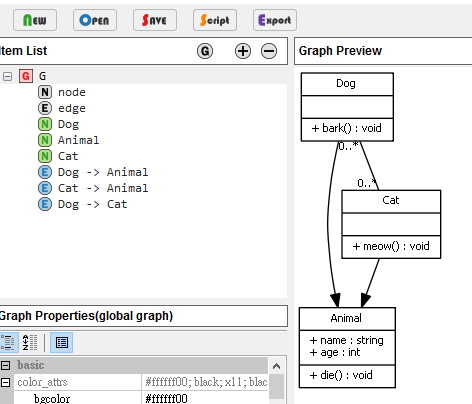dot
dot editor
http://vincenthee.github.io/DotEditor/
reference
http://www.graphviz.org/pdf/dotguide.pdf
DOT language http://www.graphviz.org/doc/info/lang.html
dot tutorial
http://www.ffnn.nl/pages/articles/media/uml-diagrams-using-graphviz-dot.php
digraph G {
fontname = "Bitstream Vera Sans"
fontsize = 8
node [
fontname = "Bitstream Vera Sans"
fontsize = 8
shape = "record"
]
edge [
fontname = "Bitstream Vera Sans"
fontsize = 8
]
}
a animal class
format
<class-name> | <fields> | <methods>
a real case - code snippet
Animal [
label = "{Animal|+ name : string\l+ age : int\l|+ die() : void\l}"
]

Animal, dot, cat 3 classes
a real case with whole script content
digraph G {
fontname="Bitstream Vera Sans";
fontsize=8;
edge [fontname="Bitstream Vera Sans",
fontsize=8];
node [fontname="Bitstream Vera Sans",
fontsize=8,
shape="record"];
Animal [label="{Animal|+ name : string\l+ age : int\l|+ die() : void\l}"];
Dog [label="{Dog||+ bark() : void\l}"];
Cat [label="{Cat||+ meow() : void\l}"];
Dog -> Animal;
Cat -> Animal;
edge [headlabel="0..*",
arrowhead="none",
taillabel="0..*"];
Dog -> Cat;
}

dot sequence diagram
dot structure
use html
digraph html {
edge [comment="Wildcard node added automatic in EG."];
node [comment="Wildcard node added automatic in EG."];
abc [shape=none,
margin=0,
label=<
<TABLE BORDER="0" CELLBORDER="1" CELLSPACING="0" CELLPADDING="4">
<TR><TD ROWSPAN="3"><FONT COLOR="red">hello</FONT><BR/>world</TD>
<TD COLSPAN="3">b</TD>
<TD ROWSPAN="3" BGCOLOR="lightgrey">g</TD>
<TD ROWSPAN="3">h</TD>
</TR>
<TR><TD>c</TD>
<TD PORT="here">d</TD>
<TD>e</TD>
</TR>
<TR><TD COLSPAN="3">f</TD>
</TR>
</TABLE>>];
}